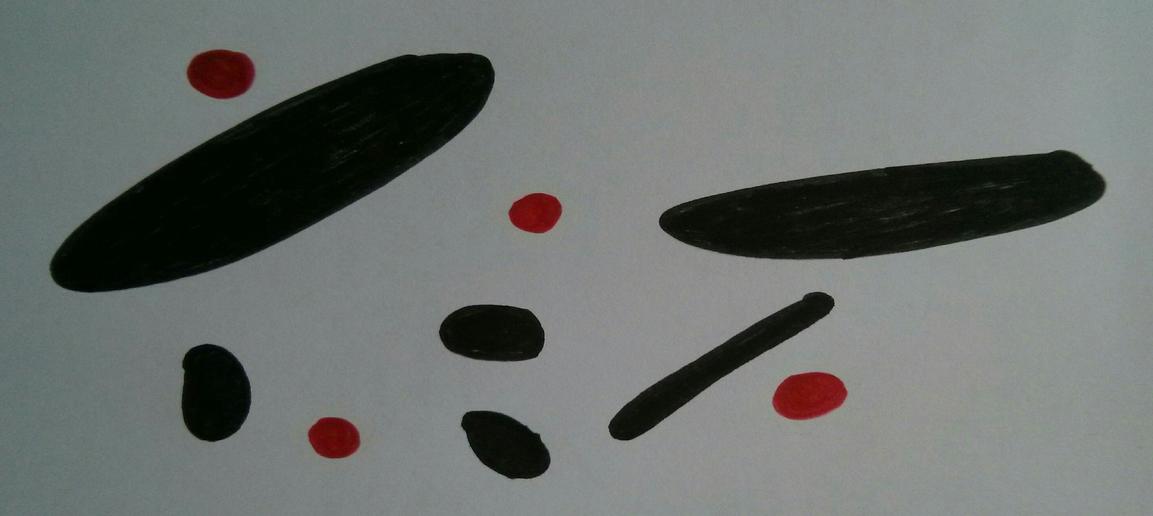Orientation an aspect ratio#
In this example, we show how to use inertia matrix of a given labeled object to find its orientation.

Required files
Before using this notebook, download the image blobs.jpg
%matplotlib widget
from PIL import Image
import numpy as np
import matplotlib.pyplot as plt
from matplotlib import cm
from scipy import ndimage
import pandas as pd
import os
path = "blobs.jpg"
files = os.listdir("./")
if path in files:
print("Ok, the file is in {0}".format(files))
else:
print("The file is not in {0} , retry !".format(files))
Ok, the file is in ['rabbit.jpg', 'image_processing_basics.ipynb', 'blobs.jpg', 'support_material.md', 'blob_orientation.ipynb']
In order to explain the concepts of inertia and aspect ratio, we use this magnificient hand drawing:
im = Image.open(path)
Nc, Nl = im.size
im = im.resize((Nc // 4, Nl // 4))
fig, ax = plt.subplots()
# ax.axis("off")
plt.imshow(im)
plt.colorbar()
plt.show()
R, G, B = im.split()
R = np.array(R)
G = np.array(G)
B = np.array(B)
plt.figure()
plt.hist(
R.flatten(),
bins=np.arange(256),
histtype="stepfilled",
color="r",
alpha=0.3,
label="Red",
)
plt.hist(
G.flatten(),
bins=np.arange(256),
histtype="stepfilled",
color="g",
alpha=0.3,
label="Green",
)
plt.hist(
B.flatten(),
bins=np.arange(256),
histtype="stepfilled",
color="b",
alpha=0.3,
label="Blue",
)
plt.grid()
plt.legend()
plt.show()
Thresholding level is obvious:
Bt = np.where(B < 50, 1, 0)
plt.figure()
plt.imshow(Bt, cmap=cm.gray)
plt.colorbar()
plt.show()
Btc = ndimage.binary_closing(Bt, structure=np.ones((5, 5)))
Bl, number = ndimage.label(Btc)
plt.figure()
plt.imshow(np.where(Bl != 0, Bl, np.nan), cmap=cm.jet)
plt.show()
number
10
obj = ndimage.find_objects(Bl)
len(obj)
10
Inertia matrix of an object#
The object represented bellow is stretched in a direction. Let’s see how we can use its inertia matrix to determine in which direction and how much it is stretched.
plt.figure()
plt.imshow(np.array(im)[obj[1]])
plt.show()
The inertia matrix of a 2D object can be defined as follows:
This matrix is symmetric and, as a consequence, it can be diagonalized in a new frame rotated by an angle \(\theta\) in the plane. This frame is composed of the two normalized eigenvectors \((\vec e_1, \vec e_2)\) of the matrix. In this frame, the matrix has two eigenvalues \((I_1, I_2)\) ordered so that \(I_1 \geq I_2\). Then:
\(\theta = (\vec x, \vec e_1)\) and,
The aspect ratio \(a = \sqrt{I_1 / I_2}\).
The angle \(\theta\) gives the direction of the elongation of the object and \(a\) shows how much it is elongated. For example, if \(a == 1\), the object is not elongated whereas if \(a=10\) it is 10 times longer in direction 1 than in direction 2 in an inertial point of view.
data = pd.DataFrame(
columns=["area", "xg", "yg", "Ixx", "Iyy", "Ixy", "I1", "I2", "theta"]
)
for i in range(len(obj)):
x, y = np.where(Bl == i + 1)
xg, yg = x.mean(), y.mean()
x = x - xg
y = y - yg
A = len(x)
Ixx = (y**2).sum()
Iyy = (x**2).sum()
Ixy = (x * y).sum()
I = np.array([[Ixx, -Ixy], [-Ixy, Iyy]])
eigvals, eigvecs = np.linalg.eig(I)
eigvals = abs(eigvals)
loc = np.argsort(eigvals)[::-1]
d = eigvecs[loc[0]]
d *= np.sign(d[0])
theta = np.degrees(np.arccos(d[1]))
eigvals = eigvals[loc]
data.loc[i] = [A, xg, yg, Ixx, Iyy, Ixy, eigvals[0], eigvals[1], theta]
data.sort_values("area", inplace=True, ascending=False)
data["aspect_ratio"] = (data.I1 / data.I2) ** 0.5
data[["area", "theta", "aspect_ratio"]]
| area | theta | aspect_ratio | |
|---|---|---|---|
| 1 | 2970.0 | 116.026308 | 3.969835 |
| 2 | 1891.0 | 96.371877 | 5.339632 |
| 4 | 442.0 | 121.962612 | 8.767714 |
| 6 | 327.0 | 3.551442 | 1.442622 |
| 5 | 296.0 | 87.196715 | 1.879190 |
| 8 | 246.0 | 57.994151 | 1.817390 |
| 0 | 153.0 | 91.013709 | 1.439440 |
| 7 | 150.0 | 100.404572 | 1.656024 |
| 9 | 94.0 | 82.012160 | 1.342536 |
| 3 | 90.0 | 97.955535 | 1.375880 |
fig = plt.figure()
counter = 1
for i in data.index.values:
ax = fig.add_subplot(3, 4, counter)
z = Image.fromarray(np.array(im)[obj[i]])
z = z.rotate(-data.loc[i, "theta"] + 90, expand=True)
z = np.array(z)
plt.imshow(z)
plt.title(str(i))
ax.axis("off")
counter += 1
# plt.grid()
plt.show()



